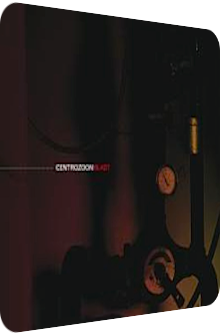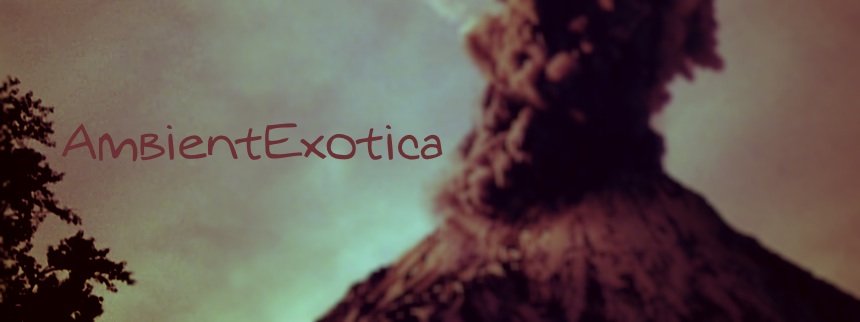
Centrozoon
Blast
(Definitive Edition)
1999/2008
Blast is the debut album of Centrozoon, back then comprising of Markus Reuter and Bernhard Wöstheinrich. Created in May and June in the year 1999 and released on the DiN label, its original four compositions are rounded off by a fifth tune when the album is re-released on Unsung Records in 2008. This isn't just another thoughtless re-release, though! The fifth track, Power, is an essential composition whose inclusion was negated back in 1999, for the people in charge at DiN decided to let it fall under the radar as it is a beat-heavy critter which would have distracted the listener from the overarching endemic ambience… supposedly. My opinion differs, but more about this later. All of the five real-time recorded "live" offerings of Centrozoon cross the ten minute-mark with ease, and each of them depicts a heavenly ethereality which then meshes – or even clashes – with more sinister motifs and tonalities. The progression of this gradual shift towards deeper, darker and gloomier realms doesn't happen all of a sudden, but is carefully set up by the duo. And in the end, the listener still doesn't have a Dark Ambient album in front of him or her. I have to confess that I didn't even know of the album until very recently when Centrozoon's third member Tobias Reber gave it to me for review purposes; let alone did I know that the roots of the duo lead to the Ambient genre! Alas, little do I know, but after several weeks of close listening sessions on various devices, in several locations and during different tasks, I'm deeply impressed and so glad that my horizon has been broadened. It is definitely much more accessible than their 2012 work, the cheekily called Boner, but we're still not in Pop Ambient realms, and with every passing minute, the depth of Blast grows.
Blast fires off with Empire, a 17+ minutes long composition that is wonderfully obliging and open for the listener to be fully submerged. Despite its ethereal textures, it is still no picayune ditty, but a masterful artwork of progression and interwoven dissonances. But first things first: the entry point is fueled by an icy tension as multiple patterns of blur waft through the air, with only lighthouse beam-evoking strings cutting through the opaque thicket thanks to their piercing clarity. Once these strings fade out with a Doppler effect, the depicted space becomes more vault-like, with enigmatically droning brazen washes whose reverberation resonates with the greyness of the background. The thickness wanes, allowing a glimpse onto the interplay of space and sound, sustain and schism, for the spluttering frizzles and claustrophobic cacophony of the synth streams depict a much gloomier, even more concentrated panorama of transcendental whirlwinds with shifting pastel colors. All things considered, the conclusion may surprise you, but Empire is totally entrancing, with just the right balance of loftiness and heaviness maintained in order to neither shift into fragile realms, nor rely on weighty walls of sounds. It's a marvelous gem, definitely deep, but purposefully reduced enough in order to let the tweaked electric guitars and spectral mellowness of the chimes meander through the aural venue. Since the second phase introduces a percussive pattern of wonky synth pads and complemental robotic bass droplets, there is a scent of liveliness perceptible that actually never distracts from the legato of the distant waves. It is the last two minutes of this epic stomper where the duo literally creates seraphic dreamscapes of rose-tinted colors that fade out ever so slowly. No bile, no harsh slivers are included, everything ends in peace. An awe-inspiring sapphire I didn't even know existed before Tobias Reber made me aware of it.
Empire is no accidental piece of awesomeness, for the following Sign is equally likeable, but pushes the deepness to abyssal, Thom Brennan-esque realms of aquatic dimensions, as this artist's work Vibrant Water (2001) previously showed. Launching in medias res with synth choir-like spirals of wind gusts and synthetic ship horn strings, it can also be compared to the cinematic darkness of Jonson's Mindlook (2008), although Sign precedes both works by quite a few years. Coldness is all over the composition of 12 minutes, with pressuring streams of frostiness, plinking bells and thin retro synth pads. This tune creates the heavy, crestfallen aura which Empire successfully avoided; the distantly whale song-like architecture of the synth strings, the filtered and flangered alterations of the accentuating washes and the blue-colored aura of the four-note bell theme altogether encapsulate the listener in a wondrous synthscape of tranquility and sub-zero temperatures sans beats. Fans of liquid artificial seascapes will fall in love with this tune. The almost 13 minutes of the follow-up Sense, on the contrary, move into sizzling-hot, ebulliently bubbling territories, but you wouldn't presume this prospect from the get-go, for the composition seems like a more mild-mannered, less insisting continuation of the underwater world of Sign: harmonious and uplifting patterns are entangled with slightly dissonant but still angelic paths, and it is the latter's habitat in higher tone ranges which injects a bold dose of mystique and arcane riddles. Bass bubbles accompany the depicted diorama and actually expand the urgency and feeling of motion. A particularly successful inclusion takes place after roundabout seven minutes when crackling Rave organs and static noise particles gyrate round the nexus of percussive bubbles. It is here that Sense revs up its heat; the occasional galactic glint in the background cannot deny this fact. The bubbles keep the pace even when the synths are long gone, a questionable but bold decision, for this percussive frame can thus be rightfully pinpointed as the signature device.
The titular Blast is the final piece of the original pre-millennial release, and sure enough does the naming convention under-promise at first and over-deliver in the end once the listener comes to grips with the characteristic trait of this tune, for there is no gargantuan outburst anywhere, but that doesn't mean that things are streamlined and silky. The first introductory notes are already scarily eerie, with a fragile but no less terrifying mélange of frightening synth choirs illuminated by pale colors. In a way, Blast swallows the listener from the beginning and depicts the same depth as the aquatic Sign, but the soundscape isn't as vibrantly filled and allows the sound-less darkness to be an important counterpoint which is possibly as soul-crushing as the actual sounds the listener hears. After four and a half minutes, Trance-like acid elements are added, but fade away immediately. It is only in the eighth minute that the string rivers are growing in voluminousness, with Horror movie-like synth strings, the return of the – now elastically bouncing – acid ornaments and a dusky outro phase with muffled temple gong-like layers. The final piece of the Definitive Edition of Blast is called Power, and while it is a strictly enthralling concoction, one can see the reasons of the DIN label's neglecting of this piece, for it starts with a 4/4 Breakbeat pattern already intact, complete with bumping didgeridoo-like curlicues in tandem with distantly howling synth strings that haunt the listener in a similar way as on Blast. After three minutes, these entities grow larger, and their gorgeously warped murkiness plus the added iridescently glacial glitz make this a pumping conclusion to a work that Wöstheinrich and Reuter initially wanted to release in this very way. If I have one quibble, it is the beat which seems to be isolated from the synth sceneries in the background, never harmoniously merging – aka clicking – with the whirling of baneful tone sequences and pressuring thrills. It is too much upfront for my taste, but I've decided to add in to my running playlist nonetheless. It may grow on me, for there is nothing wrong with the fulminantly hazardous approach.
The Definitive Edition of Blast is a late but all the more important victory for the duo incarnation of Centrozoon who finally saw their release come to fruition in the way they originally constructed it. It is a bold sign for the loss of a management's influence on indie artists. I'm sounding more cattish than I intend to, but Blast works very well, and there were indeed good reasons to strike the final track Power off, as its beat structure destroys the conceptual arc of the release. However, one can interpret its omission as a blatant failure as well, since the creepy melodies and dissonant synth strings are in fact based on the formula that is presented on all of Centrozoon's tracks on this album: mystique ever, brightness never. Even the most accessible compositions, phases or segues are always torn between a soothing part and an oppositional enigmatic bleb. It is only the opener Empire which, at least to my mind, truly mediates between the counter-opposing moods and atmospheres, delivering a fantastic tune that is neither too deep and luxurious, nor too thin and mysterious. The remaining material is undoubtedly attractive as well, even more so if you consider the status of Blast as a debut album. Sign is a lift that leads to the deepest areas below the ocean, with an ubiquitous synth thicket of liquid devices. While Sense proves to be a thermal heat source complete with static noise-infused bubbles, Blast unveils the true eeriness that has heretofore been included on each track, but never in this blatantly obvious way; Power is equally pernicious, but spices its blood-red aura with rustic beats. Above all things, Blast is a classic, proper Ambient album of the progressive, ethereal kind. It is getting darker with each track, but never overly harsh, let alone scary. I have to admit that I did not know about Centrozoon's Ambient beginnings, but I have to state yet again that my ignorance and lack of knowledge were luckily rectified by third member Tobias Reber who introduced me to the band's origins. I am more than thankful for this and will continue to feature their Ambient(-esque) releases.
Further reading:
- The band’s Twitter account is @centrozoon.
Ambient Review 145: Centrozoon – Blast (Definitive Edition) (2008). Originally published on Nov. 14, 2012 at AmbientExotica.com.
